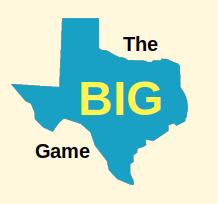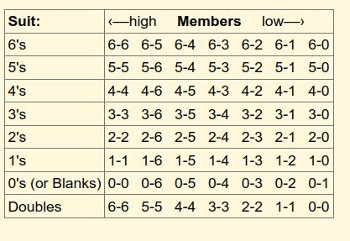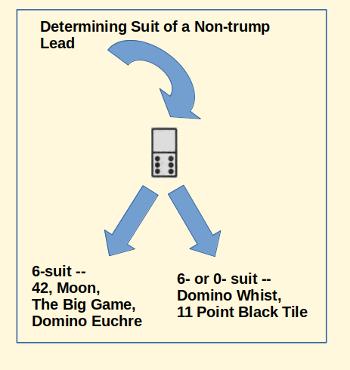Domino Trick-taking Games
Written by Howard Fosdick © BestFreeNewGames.com
When most people think of dominoes, they think of games where players link dominoes into large table layouts. In fact, the chain of matched tiles is the defining characteristic of most domino games.
But there are other kinds of domino games. In some, contestants play dominoes to tricks, exactly as in many card games. Play proceeds around the table, and each player offers a tile from their hand according to some predefined rule of trick-play. One player wins the trick and all the tiles in it.
Origins
In 19th century America, prohibitions against card playing were widespread. Conservative religious groups held that gambling was immoral, and playing cards were often associated with gambling. For many, this taboo applied to any use of playing cards, including innocent children's games.
Without card games for amusement, some turned to dominoes as a substitute. Methods were devised to play card games like Euchre, Cribbage, and Sixty-Six with dominoes. And of course gambling games followed. Look up dominoes in 19th century game books and you'll learn how to play such card games with dominoes as Loo, Rounce, Speculation, Poker, Vingt-et-Un (21), and more.
Most of these games have since died out as inferior to the card games they were meant to replace. But a few excellent games remain popular. We cover them here.
Inspiration
In Texas in the 1880s, two young Baptists found themselves punished for card play. William A. Thomas and Walter Earl were middle-school boys at the time. Having been caught playing cards in the hayloft, they determined that they'd devise a way to use dominoes as a substitute.
Inspiration struck, and the boys came up with the game today known as "Texas 42" or just "42". The game was probably modeled on Setback or a similar card game. The goal is to win tiles in trick-play, but especially those whose pips total to either 5 or 10. These tiles are the so-called counters and they're worth the number of pips on their faces.

42 is truly inspired. Many call it addictive.
Without benefit of publicity -- strictly on its merits -- over the next several decades, the game spread by word of mouth throughout Texas and even into neighboring states. Today, 42 is often called "The National Game of Texas". Many towns hold tournaments, and some family traditions involve day-long 42 parties.
42 is a fascinating game. If you haven't tried it, please see our rules for 42.
42 is strictly a four-player, partnership game. But variants for larger numbers of participants have evolved over the years. We provide rules for variants for six or even eight players arranged into two partnerships.
More Trick-Taking Games
42 also spawned a cousin called Moon. Moon lacks the counters of 42; each trick is worth one point. It is a plain trick game, as opposed to a point trick game like 42 that includes high-value counter tiles.
Sometimes 42 players turn to Moon when they lack a fourth, as it works best for three players. In this case, you use only 21 or 22 tiles (no blanks except possibly the 0-0). While many of us enjoy Moon, few would argue that it presents the intriguing puzzle that is 42.
One other trick-taking domino game of significance emerged in the 1930s. It's called 11 Point Black Tile. As in the card game Hearts, the goal is to avoid taking tricks. Specifically, players try to avoid winning the 0-0 tile and any dominoes with 3's on them. 11 Point Black Tile offers an amusing diversion for Hearts players as they grapple with the dominoes suit system.
The Big Game
We also include rules for our own 42 variant we call The Big Game.

The idea behind The Big Game was to invent a longer, slightly more challenging version of 42. The Big Game extends 42 from 7 to 11 tricks. The secret to its success is that it retains all of 42's defining ratios. (Read about the underlying statistical basis of The Big Game here).
We've found that 42 players enjoy the challenge The Big Game presents. Like 11 Point Black Tile and Moon, it's a fun alternative to straight-up 42. It's a bit more sophisticated than those other two alternatives.
Domino Whist
Texas 42 and The Big Game are both point trick games. That is, while tricks have some value, the real goal is to win specific valuable tiles. These are called the counters, and as we've mentioned, their total pips sum to either 5 or 10.
Moon abandons the point-trick principle. It has no counters, and each trick is worth one point. So, it is a plain-trick game. Moon is rather like card games in the Whist family in this way.
While fun, Moon is rather limited. The game lacks the spark that animates 42.
For this reason, I set out to create a more engaging Whist-like dominoes game. Domino Whist was the result.
This game is playable by 3, 4, or 5 players. The number of tiles in play varies by the number of players. But in all cases the game involves either 11 or 12 tricks.
What makes Domino Whist different is its mechanism for determining suit membership during tricks (explained below.) This feature, combined with 11- or 12- trick hands, makes for a thought-provoking, entertaining game.
The Suit System
Playing cards may be subdivided in any number of ways. They divide into red and black colours, for example. But their most important division is by suit. American cards exhibit four suits: Clubs, Spades, Diamonds, and Hearts. Each card is a member of one suit. Trick-taking games typically impose suit-based rules about which cards you can play to tricks.
Dominoes have a very special property. Three-quarters of the tiles in a standard set display two numbers on their face. So each is a member of two suits, instead of one. This lends domino trick-taking games a unique feel that distinguishes them from card games. It's part of the challenge these games provide.
The suit system used in trick-taking domino games is shown in the table. The 6-6 pack features eight suits: the six numbered suits, the Blanks suit, and the Doublets suit. Games typically consider the blanks to be 0's. So you could say that there are seven numbered suits running from 0 to 6, plus the Doubles suit.

Each singlet tile displays two numbers on its face. It is simultaneously a member of both of those suits. For example, the 2-3 tile is both a 2-suit and 3-suit domino.
One-quarter of the tiles in the standard 6-6 dominoes set are doublets. Each of them is a member of the single suit number on its face, and also a member of the Doubles suit. Doublets rank highest when played in any of the numbered suits, 0 through 6. Their rank when played in the Doubles suit varies.
The chart shows the ranking of the tiles in each suit, from highest to lowest. The chart demonstrates that the rank of each tile depends on the suit in which it is played. Every tile is a member of two suits.
Determining Suit
Given that each domino belongs to two suits, how do you know which suit it is when you play it?
In all the games we've described, once the trump has been determined, any tile that belongs to the trump suit is thereafter considered to be solely a trump. For example, if 2's are declared as trumps, then these tiles are members of the trump suit for that hand:
2-2 2-6 2-5 2-4 2-3 2-1 2-0
If you hold the 2-3 in your hand, it is only a member of the trump suit. It is not a 3-suit tile for the duration of the hand. Therefore, if you lead the 2-3, it is considered a trump-suit lead.
For 42, The Big Game, Moon, and Domino Euchre, when a player leads any non-trump tile, the higher number on the tile determines its suit. Lead a 1-3, for example, and you lead a 3-suit tile having the rank of 1. Lead a 6-0, and you lead the lowest member of the 6's suit.

Domino Whist and 11 Point Black Tile follow a different rule. In these two games, the trick leader specifies the suit of any non-trump domino he leads. Lead a 0-6 tile, for example, and you could state either that you are leading a 0-suit domino or a 6-suit tile.
Lead the 4-4, and you can dictate that you're leading either a 4-suit tile, or a doublets-suit domino.
(Of course, there is no choice when leading a trump-suit tile. It is always considered a trump-suit lead.)
That the trick leader gets to choose which of two suits he leads makes a huge difference in Domino Whist.
It yields the power to shape your hand for as long as you hold the lead. For example, dominoes like the 0-6 or 1-6 rank second highest in their suits if properly led. On the other hand, if some other player leads and declares tricks in the 6's suit, these tiles rank low and have little value.
This principle is what makes Domino Whist an engaging game. You need the mental agility to see in which suits you'll play your tiles. And you need to know how to grab and maintain the lead to capitalise on what you have in your hand.
Final Words
Many dominoes players aren't aware that there is an entire world of games in which participants play dominoes to tricks. 42 is the granddaddy of these games, and remains a premier game even today, a century and a half since its invention.
Moon and 11 Point Black Tile have been around since at least the 1930s. They offer credible alternatives to 42 for an entertaining change of pace.
I've added two more tile tricksters to the mix. The Big Game extends 42 to more tricks and a longer game, while Domino Whist explores new territory as a Whist-like tile game. We hope you enjoy these games and welcome your feedback.
Summary:
| Game | Players | Type | Set | Tricks | Suit for Non-trump Lead |
| 42 | 4 | Point Trick | 6-6 | 7 | High suit on tile |
| The Big Game | 4 | Point Trick | 8-8 | 11 | High suit on tile |
| Moon | 3 | Plain Trick | 6-6 no blanks, 0-0 optional | 7 | High suit on tile |
| 4 | Plain Trick | 6-6 | 7 | High suit on tile | |
| Domino Euchre | 4 | Plain Trick | 6-6 | 5 | High suit on tile |
| 11 Pt Black Tile | 3 | Trick Avoidance | 6-6 | 9 | Leader's choice |
| 4 | Trick Avoidance | 6-6 | 7 | Leader's choice | |
| Domino Whist | 3 | Plain Trick | 7-7 | 12 | Leader's choice |
| 4 | Plain Trick | 8-8 | 11 | Leader's choice | |
| 5 | Plain Trick | 9-9 | 11 | Leader's choice |
License: Copyright © 2023 by H. Fosdick. HOME